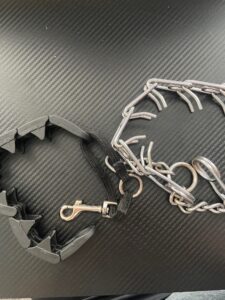There is a lot of misleading and false information about training collars and the miss use of them. There are mainstream people who claim the prong collar or starmark collar are abusive. Before we get into that lets establish means of words. The definition of abuse as defined by Cambridge dictionary as “to use something for the wrong purpose in a way that is harmful or morally wrong”. With that definition anything can be abused, feeding your dog to much and causing weight gain can be abusive. Running your dog to much is abusive. These collars are a tool nothing more. It is how the tool is used. That is why ethical trainers such as myself uses them within the paramotors of LIMA. We are not juking the dog. A correction with one of these collars is a minimal as possible using a figure pump. We are causing an announce not pain to teach the dog that it has to obey and when it does it gets to be rewarded with praise and treats. Remember anything can be misused within dog training. If you dog trainer is using training collars ask them to explain in detail how they work, have the taught the dog what it means and how to avoid it.
Dog training encompasses a variety of techniques and tools, each with its own proponents and critics is the prong collar. Also known as a pinch collar or training collar, the prong collar is designed to provide a means of control during training sessions. However, its use is surrounded by controversy, with proponents arguing its effectiveness and critics expressing concerns about its potential harm. In this article, we’ll delve into the details of the prong collar, examining its purpose, proper usage, potential risks, and alternatives.
What is a Prong Collar?
A prong collar, also known as a pinch collar, is a type of training collar designed to provide gentle yet effective control over a dog’s behavior. It consists of a series of metal links with blunt prongs that gently press into the dog’s neck when tension is applied, mimicking the natural correctional bite of a mother dog.
Controversy Surrounding Prong Collars
Prong collars have sparked controversy among dog owners, trainers, and animal welfare advocates. Critics argue that the use of prong collars may cause discomfort or pain to dogs and can potentially lead to physical injury or behavioral issues if used incorrectly. Proponents, on the other hand, believe that prong collars can be an effective tool for managing strong-willed or unruly dogs when used properly and under the guidance of a knowledgeable trainer.
Proper Use and Application
When used responsibly, prong collars can be an effective training tool for certain dogs, particularly those with a history of pulling on the leash or exhibiting other challenging behaviors. It’s essential to ensure proper fit and placement of the prong collar to minimize discomfort and avoid injury to the dog’s neck. Additionally, prong collars should only be used as part of a comprehensive training program that includes positive reinforcement techniques and rewards for desired behaviors.
Considerations for Training with Prong Collars
Before using a prong collar in training, it’s crucial to consider the individual needs and temperament of the dog, as well as the handler’s level of experience and proficiency in using the tool. Prong collars are not suitable for all dogs, and alternative training methods should be explored for dogs with sensitivity or aversion to collar corrections. Consulting with a qualified professional dog trainer can help determine whether a prong collar is appropriate for your dog’s specific training needs.
The Importance of Positive Reinforcement
Regardless of the training tools used, positive reinforcement remains the foundation of effective and humane dog training, addressing dog behavioral problems with care. Rewarding desired behaviors with treats, praise, and play helps build a strong bond between dogs and their handlers, encouraging dogs to repeat those behaviors in the future. Incorporating positive reinforcement techniques alongside training with prong collars can help ensure a balanced and compassionate approach to training, effectively managing dog behavioral problems.
Conclusion: Navigating the Controversy
In conclusion, at SpeciesK9, we acknowledge the controversy surrounding prong collars in dog training. While some view them as effective tools for gentle correction, others worry about potential harm to dogs. We advocate for informed decision-making, considering each dog’s needs and exploring alternative methods when appropriate. Our focus is on creating a safe and positive training environment that prioritizes the well-being and positive reinforcement of our canine companions, fostering trust and mutual understanding between dogs and their owners.
At our company, SpeciesK9, we specialize in providing expert dog training services in Waco, ensuring a tailored approach to meet both the unique requirements of your furry friend and your training goals.
FAQ’s
Is it safe to use a prong collar on all dogs?
Prong collars may not be suitable for all dogs, especially those with neck or respiratory issues. It’s crucial to consult with a veterinarian or professional trainer before using a prong collar, particularly on puppies or elderly dogs.
How do I know if I’m using a prong collar correctly?
Proper fit and positioning are essential when using a prong collar. It should fit snugly high on the dog’s neck, with the prongs facing inward. If you’re unsure, seek guidance from a qualified trainer or behaviorist.
What should I do if my dog reacts negatively to a prong collar?
If your dog exhibits signs of discomfort or distress when wearing a prong collar, discontinue its use immediately and consult with a professional trainer or behaviorist. There may be alternative training methods better suited to your dog’s needs.

